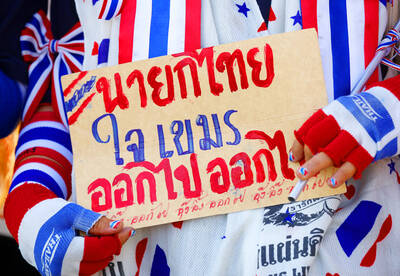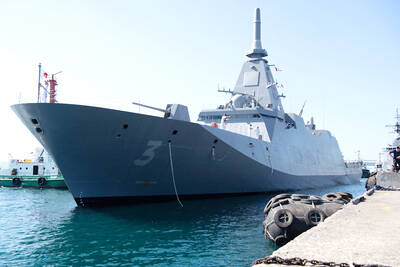Nepal, the world’s newest republic, is set for more major change after the Maoist leader and former warlord Prachanda was appointed prime minister and promised to deliver a left-wing revolution.
The charismatic leader — whose nom-de-guerre means “the fierce one” — was overwhelmingly voted in as the impoverished country’s most powerful man in a vote by lawmakers on Friday evening.
His ascent from rebel to national leader clears the way for his band of ultra-leftists, who feature on a US terrorist blacklist, to plough ahead with their vow to radically reform the country.

PHOTO: AP
Nepal has already undergone momentous change over the past two years, which have seen the Maoists end a decade-long revolt and sign up for peace, unpopular king Gyanendra sacked, and a 240-year-old monarchy abolished.
Maoist number-two and top ideologue Baburam Bhattarai hailed a “golden dawn” — and more historic change.
“We feel that Nepal has found its hero. For any epoch-changing society, we need a hero,” he said of Prachanda, a 53-year-old former school teacher.
“After Europe’s capitalist revolution, Napoleon came along. To institutionalize socialism in Russia, Lenin appeared. In Nepal, to institutionalize the federal democratic republic after 10 years of People’s War and mass popular movement, Prachanda is here,” Bhattarai said.
“We have already finished destroying the roots of feudalism in Nepal. Under the leadership of Prachanda, the main agenda of the new administration will be nationalism, republicanism, economic and social transformation,” he said.
In April, Prachanda steered his party to victory in elections for a new national assembly, set up as part of a peace deal to abolish the monarchy and write a new constitution.
But as prime minister he will face huge challenges, including urgently dealing with soaring food and fuel prices that have paralyzed an economy struggling to recover from the civil war.
Millions of poor who backed the party will also be impatient to see quick land reforms that the ex-rebels argue are needed to lift much of the landlocked country out of grinding poverty.
There is also the issue of integrating the 20,000-strong rebel army, currently confined to UN-monitored camps, into the national army.
“The integration of the People’s Liberation Army into the Nepal Army will see lots of arguments and counter-arguments. The way they deal with the army is very crucial,” said Amit Dhakal, editor of the Kathmandu Postnewspaper.
“The Maoists will try to bring in populist and radical economic reforms. But financially they will have lots of constraints,” Dhakal said.
Prachanda, who was inspired by China’s Chairman Mao Zedong (毛澤東) and Peru’s Shining Path, has also had trouble shaking off his image as a ruthless warlord.
Critics say the ultra-leftists have yet to fully abandon violence and that their feared youth wing — the Young Communist League — must disband in order to prove they are committed to peaceful democracy.
The other candidate for prime minister who Prachanda defeated, veteran centrist politician Sher Bahadur Deuba, warned the ex-rebels that they would not be allowed to “incline towards autocracy.”
The first test will be the formation of a government, a process already in motion with the Maoists required to share portfolios with the parties who backed them in the assembly vote for Prachanda.

Eleven people, including a former minister, were arrested in Serbia on Friday over a train station disaster in which 16 people died. The concrete canopy of the newly renovated station in the northern city of Novi Sad collapsed on Nov. 1, 2024 in a disaster widely blamed on corruption and poor oversight. It sparked a wave of student-led protests and led to the resignation of then-Serbian prime minister Milos Vucevic and the fall of his government. The public prosecutor’s office in Novi Sad opened an investigation into the accident and deaths. In February, the public prosecutor’s office for organized crime opened another probe into

RISING RACISM: A Japanese group called on China to assure safety in the country, while the Chinese embassy in Tokyo urged action against a ‘surge in xenophobia’ A Japanese woman living in China was attacked and injured by a man in a subway station in Suzhou, China, Japanese media said, hours after two Chinese men were seriously injured in violence in Tokyo. The attacks on Thursday raised concern about xenophobic sentiment in China and Japan that have been blamed for assaults in both countries. It was the third attack involving Japanese living in China since last year. In the two previous cases in China, Chinese authorities have insisted they were isolated incidents. Japanese broadcaster NHK did not identify the woman injured in Suzhou by name, but, citing the Japanese

YELLOW SHIRTS: Many protesters were associated with pro-royalist groups that had previously supported the ouster of Paetongtarn’s father, Thaksin, in 2006 Protesters rallied on Saturday in the Thai capital to demand the resignation of court-suspended Thai Prime Minister Paetongtarn Shinawatra and in support of the armed forces following a violent border dispute with Cambodia that killed more than three dozen people and displaced more than 260,000. Gathered at Bangkok’s Victory Monument despite soaring temperatures, many sang patriotic songs and listened to speeches denouncing Paetongtarn and her father, former Thai prime minister Thaksin Shinawatra, and voiced their backing of the country’s army, which has always retained substantial power in the Southeast Asian country. Police said there were about 2,000 protesters by mid-afternoon, although

MOGAMI-CLASS FRIGATES: The deal is a ‘big step toward elevating national security cooperation with Australia, which is our special strategic partner,’ a Japanese official said Australia is to upgrade its navy with 11 Mogami-class frigates built by Japan’s Mitsubishi Heavy Industries, Australian Minister for Defence Richard Marles said yesterday. Billed as Japan’s biggest defense export deal since World War II, Australia is to pay US$6 billion over the next 10 years to acquire the fleet of stealth frigates. Australia is in the midst of a major military restructure, bolstering its navy with long-range firepower in an effort to deter China. It is striving to expand its fleet of major warships from 11 to 26 over the next decade. “This is clearly the biggest defense-industry agreement that has ever